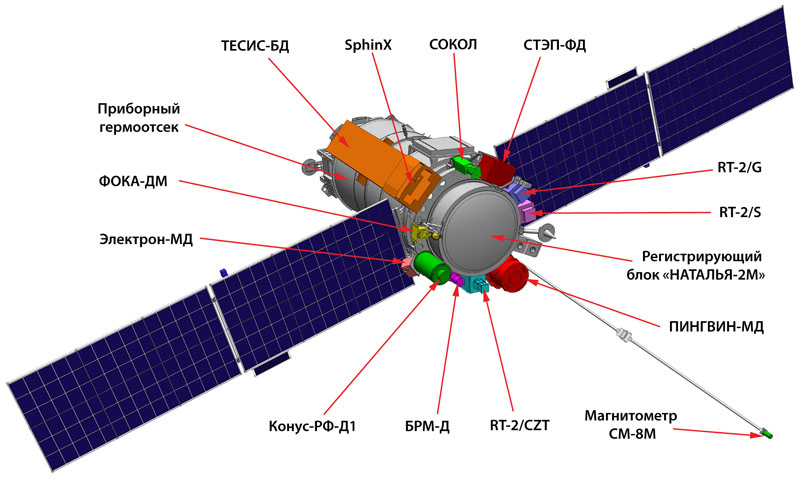
|
Coronas-Photon (Electron-M Pesca experiment)
| [Overview] [Particle fluxes] [Chart archive] [FTP archive] |

Coronas-Photon (Russian: Коронас-Фотон) or Complex Orbital Observations Near-Earth of Activity of the Sun, is a Russian solar research satellite. It is the third satellite in the Russian Coronas programme, and part of the international Living With a Star programme. It was launched on 30 January 2009, from Site 32/2 at the Plesetsk Cosmodrome, aboard the final flight of the Tsyklon-3 rocket.
The goal is to investigate the processes of free energy accumulation in the sun's atmosphere, accelerated particle phenomena and solar flares, and the correlation between solar activity and magnetic storms on Earth. Launch occurred succesfully on 30 January 2009, and the first batch of science data was downloaded from the satellite on 19 February 2009. The satellite operates in a 500 x 500km x 82.5° polar low Earth orbit and is expected to have a operational lifetime of three years.
Coronas-Photon is a successor to the Coronas-F and Coronas-I satellites, launched in 1994 and 2001 respectively. It is being operated by the Russian Federal Space Agency, the Moscow Engineering Physics Institute and the Research Institute for Electromechanics. It was built using a bus constructed for Meteor-M weather satellites.
Coronas-Photon hosts a wide range of experiments, including Electron-M PESCA conducted by SINP.
Instrument (Electron-M Pesca)
The device allows to detect:
- protons ( 4 - 80 MeV )
- electrons ( 0,2 - 3 MeV )
- alpha - particles ( 5 - 24 MeV / nucl )
- particles of C, N, O group ( 6 - 15 MeV / nucl )
Registration of fluxes of particles - up to 5*107 particles / sm2 * sec * ster
Parameters of an orbit: a circular orbit, height - 500 km, an inclination - 82.5
Device:
The device consists of two blocks:
- The block of detectors ELECTRON-MD-PESCA (E-MD-P) - serves for registration of the charged particles (The detector part of this block is four-element semi-conductor telescope with the area of ~12 sm2 and thickness of each of the detectors equal to 0.375 mm of working area)
- The block of electronics ELECTRON-ME-PESCA (E-ME-P) - serves for the data counting, data storage and for a taking out of the data to a telemetry
Overall dimensions of blocks of the device:
ELECTRON-MD-PESCA - 200 x 186 x 140 mm
ELECTRON-ME-PESCA - 258 x 150 x 150 mm
Weight of blocks of the device:
The ELECTRON-MD-PESCA block - 2.2 +/- 0.2 kg
The ELECTRON-ME-PESCA block - 2.8 +/- 0.2 kg
| № channels | particle energies, MeV | GeomFactor, cm2 sr |
| kfe0d2_1 | е – 0, 2 – 1,0 MeV | 22+/-5 |
| kfp4_16 | р – 4 - 16 MeV | 24+/-2 |
| kfa5_16 | alpha 5 - 16 MeV/nucleon | 15+/-5 |
| kfc6_15 | CNO nuclei group 6 – 15 MeV/nucleon | 20+/-5 |
| kfe1_4 | е - 1,0 – 4,0 MeV | 2.5+/-0.5 |
| kfp16_28 | р – 16 - 28 MeV | 8.5+/-2 |
| kfa16_24 | alpha – 16 - 24 MeV/nucleon | 21+/-1 |
| kfe4_ | е - > 4,0 MeV | 12+/-3 |
| kfp41_55 | р – 41 - 55 MeV | 15+/-3 |
| kfp80_ | р – > 80 MeV | 12+/-2 |
Power consumption of the device:
Under normal conditions and for a voltage of 27 Volt - no
more than 13.5 Watt
(E-MD-P Block < 2.0 Watt, E-ME-P Block < 11.5 Watt)
Coronas-Photon also carries three Indian Roentgen Telescope or RT instruments: RT-2/S, RT-2/G, and RT-2/CZT. These will be used to conduct photometric and spectrometric research into the Sun, and for low-energy gamma-ray imagery. These instruments will be operated by the Indian Space Research Organisation (ISRO), and were constructed by a collaboration of the Vikram Sarabhai Space Centre, Tata Institute of Fundamental Research and Indian Centre for Space Physics.
Developed in 2007. Copyright © 2007 - 2026 Skobeltsyn Institute of Nuclear Physics Moscow State University Feedback